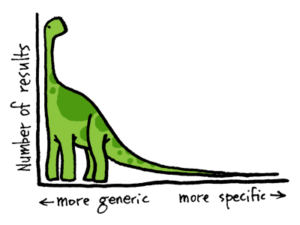Long tail marketing strategy refers to the strategy of targeting a large number of niche segments in markets with a product or service. Niche marketing means a marketing strategy of narrowing down focus on product/service offerings to target of small but profitable subsection of a market. Small niches in market are overlooked by dominating market leaders. The best example I can give here is of Netflix Inc. which is an American media-service provider headquartered in California, founded in 1997. The company’s primary business is its subscription-based streaming OTT (Over the Top) service which offers online streaming of a library of films and television programs, including those produced in-house. As of April 2019, Netflix has over 148 million paid subscriptions worldwide, including 60 million in the United States, and over 154 million subscriptions total including free trials.
Long Tail first came into existence because of the Internet culture seen in a significant post by Clay Shirky titled “Powerlaws, Weblogs, and Inequality” he studied why certain weblogs (the original term for blogs) had a power law distribution. It was Chris Anderson who expanded the theory to explore implication for culture, and for business, and coined the term Long Tail. He coined the term in 2004. He pointed that the products in low demand or with low sales volume can collectively make up market share or exceeds the relatively few current bestsellers and blockbusters but only if the store or distribution channel is large enough. He pointed out that the internet gave consumers choices beyond what was offered in physical stores; e-Commerce offers niche markets the chance to appeal to their audience through major marketplaces like Amazon, Flipkart, Alibaba. With the wake of e-commerce growing in popularity, coupled with affordable shipping or digital downloads, there’s always someone out there looking to buy even the most specialized products. Amazon and Alibaba can buy items in large quantities, lowering the price of the product.
In many retail stores, a small group of popular items such as Shapewear which is shaping up to be one of the best evergreen niche product in a store. For past two years in row, this product category has made to the list. By 2022, the shapewear market is expected to skyrocket to about $ 5.6 billion in sales. What started as an undergarment has transitioned to a piece for everyday wear. Similarly, in the autumn season and early winter months, plaid shirts searches re-emerge as a seasonal trend. This fashion product item has created a standalone category in retail outlets called “Plaid,” and is considered trendy. Such new niche products help the sales to soar. Many stores automatically promote these already popular items, trying to attract as many customers as they can before their competitors do. Meanwhile, their other inventory continues to sell, without special promotion. However, some stores carry such a variety of inventory that their less popular items, in total, actually make up the bulk of sales. If they plot the number of sales of each individual product, they observe that their distribution curve looks dominant like a long tail because of niche products.
Long tail marketing concentrates on innovative yet less popular products. While many marketing strategies focus on promoting a specific product or brand, long tail marketing involves more inventory management than the product promotion. The fact is this business model is based on the 80/20 rule of the Pareto principle; Amazon and Netflix stock items in centralized warehouses, while displaying them on a virtually unlimited sales floor (their website), resulting in a much lower cost for shelf maintenance. Web-page maintenance has its costs, but they are substantially lower than physical storage which requires sorting, stocking, and maintaining shelves. Meanwhile, sellers of digital products such as iTunes, or Amazon’s Kindle books don’t even require warehouse space, further reducing the maintenance costs.
A brick-and-mortar video rental store or bookstore requires so much shelf space for staking the books and videos, and must devote a significant amount of that space to stocking enough of the most popular items to meet demand. Less popular items compete with each other for limited space, and greater variety increases costs in time and energy in stocking and sorting.
The principles of long tail marketing are also applied by microfinance businesses who offer smaller loans to large groups of people all over the world. A loan of less than $100 is enough to start a business in many places. These customers, who often have no established credit history, have long been ignored by traditional banks; but now represent a significant niche market, and an important component of economic growth in many regions of the world, including Africa and Southern Asia. The plus points of long tail business strategy are as follows:
It offers lower costs to store in terms of distribution and supply: Long tail is suitable because of the lower cost of storing/stocking and near unlimited potential for distributing products. Centralized warehouses are substantially less expensive than retail chains with local stores. Winners achieve better distribution, logistics, inventory management, warehousing, and ultimately have more data to determine how to price and scale.
Lower merchandising costs: Web and mobile storefronts have the ability to display huge amounts of inventory. By reducing the search costs for the average customer, and the cost to display inventory, long tail models increase the collective share of remote and difficult to get products.
Suggestion engines: Both Amazon and Netflix are famous for their “and you may also like” recommendation tools. It works wonders. The recommendation engines shift demand to the long tail of the demand curve, away from the hits on popular books, media, and products that drive traditional retail demand and toward niche undiscovered products. Based on the use of collaborative filters, preference for a popular product can shift demand back to hits or popular titles.
Opinion of crowd input matters: The way users find what they are looking for is often by recommendations of the volunteers, contributing connections and collaborating directly with a company to create and organize information. Google is successful in creating a long tail of web search with the direct involvement of everyone that uses Google; this contributes linked content on the web.
Data analytics informs product development: Data analytics is famous for using the customer preference data collected over time to deliver not just a marketplace of products, but original content based on deep customer intelligence. Amazon has smartly already launched its own private label brand to sell diaper products, and most recently announced future food products.
The flipside: On the flipside there has been much debate in the academic and business community about the validity of long tail as a feasible business model, and the term is no longer popular for freshly brewed startups. Many neo-entrepreneurs are challenging the potential value of long tail. However, it is worth understanding the basic assumptions which laid the foundation for early thinking in the value of internet delivery. The idea of long tail as a business model has changed with Amazon’s domination of online retail. Amazon literally dominates every possible category. A key question to authenticate a long tail theory is would a company benefit from a wider distribution of inventory, both in terms of inventory and search costs?















































